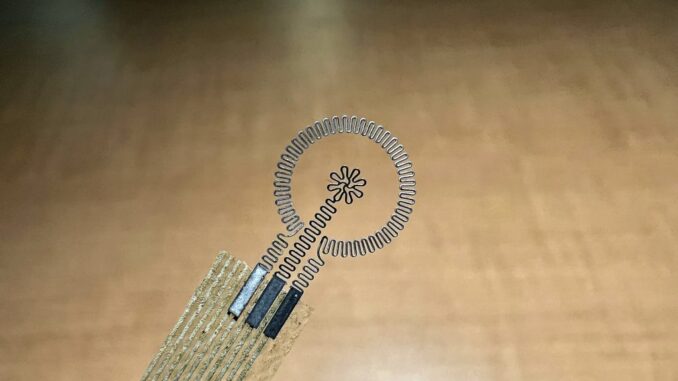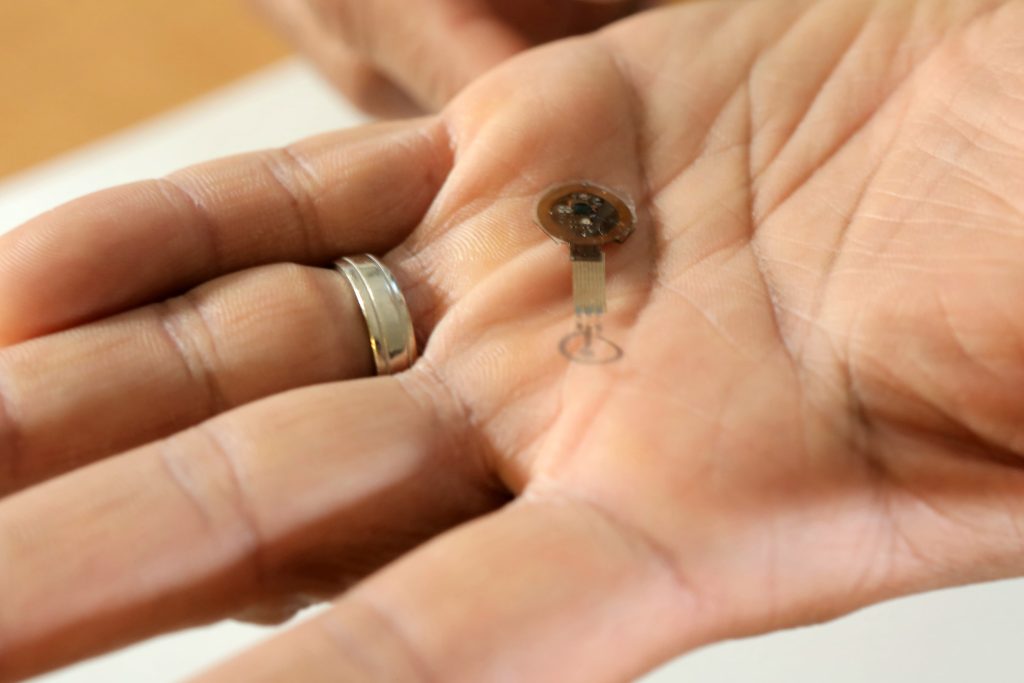
New electronic bandages could speed up the healing process by 30 percent, according to a study.
The wireless, battery-free bandage delivers electrical signals to help heal wounds and stream data about how the injury is getting on in real-time to a smartphone or tablet.
After the wound is healed the bandage harmlessly absorbs into the body – electrodes and all.
The new device could provide a powerful tool for patients with diabetes, whose ulcers can lead to various complications, including amputated limbs or even death.
In an animal study, even after just 30 minutes the new bandage healed diabetic ulcers 30 percent faster than in mice without the bandage.
Dr. Guillermo Ameer, a professor of biomedical engineering from Northwestern University and a co-author of study, said: “When a person develops a wound, the goal is always to close that wound as quickly as possible. Otherwise, an open wound is susceptible to infection.
“And, for people with diabetes, infections are even harder to treat and more dangerous.
“For these patients, there is a major unmet need for cost-effective solutions that really work for them.
“Our new bandage is cost-effective, easy to apply, adaptable, comfortable and efficient at closing wounds to prevent infections and further complications.”
Dr. John Rogers of Northwestern University and another co-author, added: “Although it’s an electronic device, the active components that interface with the wound bed are entirely resorbable.
“As such, the materials disappear naturally after the healing process is complete, thereby avoiding any damage to the tissue that could otherwise be caused by physical extraction.”
According to Diabetes UK, more than four million people in Britain are currently suffering from diabetes.
The organization claims: “More people than ever are at risk of type 2 diabetes.
“If nothing changes, we predict that 5.5 million people will have diabetes in the UK by 2030.”
In the U.S., nearly 30 million people have diabetes and 15 to 25 per cent of them will develop diabetic foot ulcers at some point in their lives.
These ulcers occur as nerve damage caused by diabetes can lead to numbness, making simple blisters and small scratches go unnoticed and untreated.
These wounds can also be difficult to heal due to diabetics’ high glucose levels. This can thicken capillary walls in the body, slowing down blood circulation.
Electrical stimulation could help those suffering from these stubborn wounds, as injuries can disrupt the body’s normal electrical signals.
Applying electrical stimulation restores the body’s normal signals, attracting new cells to migrate to the wound bed.
Dr. Ameer added: “Our body relies on electrical signals to function.
“We tried to restore or promote a more normal electrical environment across the wound.
“We observed that cells rapidly migrated into the wound and regenerated skin tissue in the area.
“The new skin tissue included new blood vessels, and inflammation was subdued.”
The bandage is small and flexible and wraps around the injury site.
One side contains two electrodes. The first is a tiny flower-shaped electrode that sits right on top of the wound bed.
The second is a ring-shaped electrode that is positioned on healthy tissue to surround the entire wound.
On the other side there is an energy-harvesting coil to power the system and a near-field communication (NFC) system that wirelessly transports data in real time.
Sensors have also been included so doctors can see how well the wound is healing without any follow up appointments.
They do this by measuring the resistance of the electrical current across the wound.
As the wound gets better the electrical current measurement gets lower.

Dr Ameer said: “As a wound tries to heal, it produces a moist environment.
“Then, as it heals, it should dry up. Moisture alters the current, so we are able to detect that by tracking electrical resistance in the wound.
“Then, we can collect that information and transmit it wirelessly.
“With wound care management, we ideally want the wound to close within a month. If it takes longer, that delay can raise concerns.”
When the wound is healed, the flower-shaped electrode simply dissolves into the body.
The electrodes are made of the metal, molybdenum, which is widely used in electronic and semiconductor applications.
When this metal is thin enough it can biodegrade, meaning it can disappear on its own without interfering with the healing process.
Dr. Ameer added: “We are the first to show that molybdenum can be used as a biodegradable electrode for wound healing.
“After about six months, most of it was gone. And we found there’s very little accumulation in the organs. Nothing out of the ordinary.
“But the amount of metal we use to make these electrodes is so minimal, we don’t expect it to cause any major issues.”
Electrotherapy healing equipment is usually bulky and wired, meaning that it can only be used under supervision in a hospital setting.
The team partnered with Rogers, a bioelectronics pioneer who first introduced the concept of bioresorbable electronic medicine in 2018.
The team now plans to test their bandage for diabetic ulcers in a larger animal model, with hopes to test it eventually on humans.
As the bandage leverages the body’s own healing power without releasing drugs or biologics, it faces fewer regulatory hurdles.
This means patients could potentially see it on the market much sooner.
The study was published in the journal Science Advances.
Produced in association with SWNS Talker
Recommended from our partners
The post How These New Electronic Bandages Could Speed Up The Healing Process appeared first on Zenger News.
